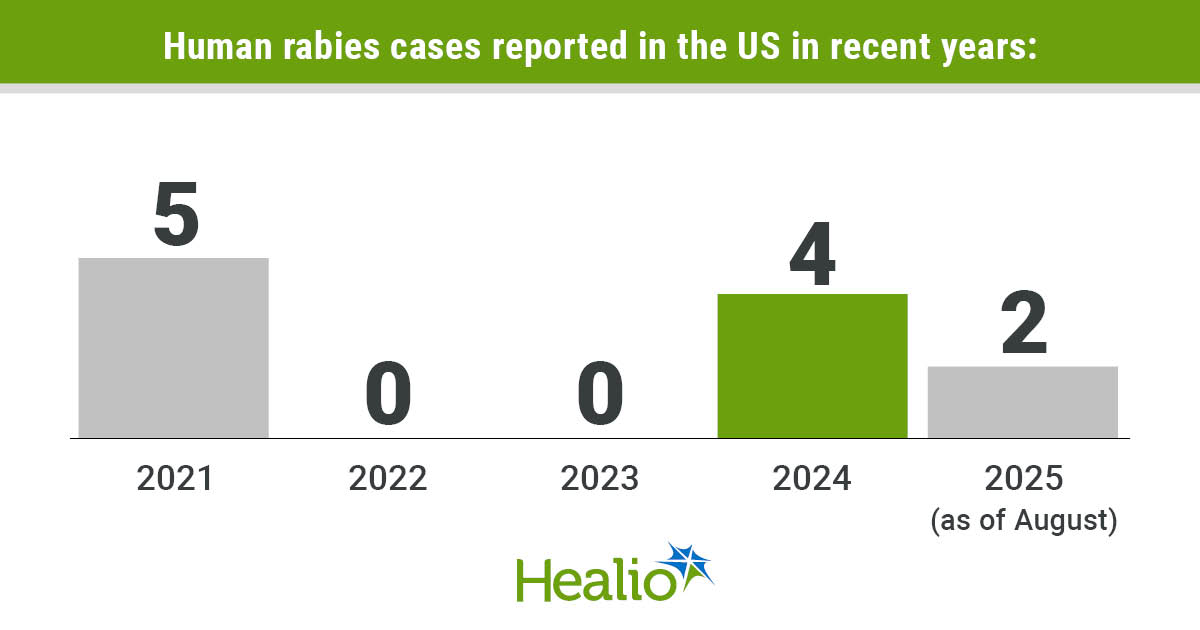September 22, 2025
4 min read
Key takeaways:
- Preliminary data show cases of rabies in the U.S. may have slightly increased in 2025.
- Two human rabies deaths have been reported so far this year.
Cases of rabies — among animals and humans — may be on the rise in the United States, although experts were hesitant to say there is a surge in the deadly viral disease.
Multiple news outlets have published stories recently warning of a rise in rabies outbreaks or outlining the continued threat of rabies to humans and animals in the U.S.

Data derived from CDC.
“It’s important to note that our ability for early detection of rabies outbreaks and unusual events has improved in the last decade because of improved laboratory methods and more rapid ways of sharing data between labs, state health departments and CDC,” Cassandra Boutelle, MPH, a CDC health scientist, told Healio. “Therefore, it is difficult to directly compare the number of outbreak events tracked each year as an indicator of a broader, national rabies emergency.”
CDC data from recent years show there were 3,760 animal cases and four outbreaks reported in 2023, 3,834 cases and 13 outbreaks in 2024, and there have so far been 2,081 animal cases and 13 outbreaks in 2025, which Boutelle said is consistent with the country’s 5-year average.
Ryan Wallace, DVM, MPH, a CDC veterinary medical officer, explained that there are more than 30 unique rabies virus variants that have adapted to infect specific animals in the U.S.
A recent outbreak was reported in a feral cat colony in Maryland, but most rabies infections among animals in the U.S. occur in foxes, bats, raccoons and skunks, according to the CDC.
Bats surpassed racoons as the No. 1 cause of human rabies infections in the country around a decade ago. Infections caused by dog bites — the source of most human rabies cases globally — have declined steadily in the U.S. over the past century due to effective vaccination and control programs, according to the CDC.
In terms of human cases, CDC data show there were zero reported in 2019 and 2020, five reported in 2021, zero in 2022 and 2023, four in 2024 and two so far in 2025.
Rabies in humans is almost always fatal once symptoms appear. It can be prevented through vaccination (for those who are eligible) and post-exposure prophylaxis, which includes wound care, human rabies immune globulin and four shots of rabies vaccine given over the course of 2 weeks, the CDC notes.
Of the two cases and subsequent deaths reported in 2025, one occurred in a child who was exposed to rabies in India through a dog bite and died after coming to the U.S.
The second case and death reported this year involved an organ transplant patient who died of rabies after receiving the organ of a person who was bit by an infected skunk.
Media outlets reported the transplant death in late March. According to ABC News, the Michigan resident received a kidney from a deceased donor who was exposed to a wild animal in Idaho 5 weeks before their death. The person did not seek medical care and later died without “traditional rabies symptoms,” so the incident was not reported to public health officials.
The outlet also reported that corneal grafts from the same donor’s eyes were transplanted into three patients in three different states and that a fourth corneal graft was stopped before it could be implanted. All of the transplant patients received rabies post-exposure prophylaxis following the death of the kidney recipient.
In addition to the 2025 deaths, Wallace said human deaths in previous years include the person who died after transmission from the skunk, another patient who was exposed in another country and developed rabies after coming to the U.S. and several patients who died after being exposed to bats.
“The wide variation in how these rabies deaths were exposed to rabies virus is a stark reminder that rabies virus is present in numerous parts of the world and can be found in many animal species,” Wallace said. “Avoiding direct contact with wildlife, being familiar with rabies risks prior to international travel, and speaking with a public health official if you have had a concerning exposure are all important steps to take to prevent rabies.”
References:
- Anthes E. Rabies is spreading in South African seals, scientists say. The New York Times. July 25, 2025. https://www.nytimes.com/2024/07/25/health/rabies-cape-fur-seals-south-africa.html. Accessed Sept. 22, 2025.
- CDC. About rabies. https://www.cdc.gov/rabies/about/index.html. Updated June 24, 2025. Accessed Sept. 22, 2025.
- Hetter K. The US is tracking 14 potential rabies outbreaks in 20 states. Here’s what to know. CNN. Sept. 18, 2025. https://www.cnn.com/2025/09/18/health/rabies-animal-vaccine-disease-health-wellness. Accessed Sept. 22, 2025.
- Ma X, et al. J Am Vet Med Assoc. 2024;doi:10.2460/javma.24.05.0354.
- Kopf M, et al. Outbreaks of rabies seem to be rising across the U.S., CDC surveillance shows. NBC News. Aug. 31, 2025. https://www.nbcnews.com/health/health-news/rabies-outbreaks-rising-us-deaths-vaccine-rcna227771. Accessed Sept. 22, 2025.
- Salzman S, et al. Michigan resident dies of rabies after undergoing organ transplant in Ohio: Officials. ABC News. March 28, 2025. https://abcnews.go.com/Health/michigan-resident-dies-rabies-after-undergoing-organ-transplant/story?id=120217114. Accessed Sept. 22, 2025.
- Sudhakar S. Deadly rabies cases pose public health threat across US, experts warn. Fox News. Sept. 5, 2025. https://www.foxnews.com/health/deadly-rabies-cases-pose-public-health-threat-across-us-experts-warn. Accessed Sept. 22, 2025.
For more information:
Cassandra Boutelle, MPH, and Ryan Wallace, DVM, MPH, can be reached at media@cdc.gov.









